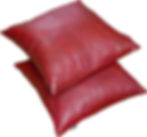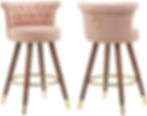Color Psychology in Interior Design
- Basil & Olive Design
- Jan 6, 2024
- 4 min read
Updated: Jan 25, 2024
The Psychology of Color in Interior Design
Color psychologically impacts interior design by influencing emotions, mood, and perceptions within a space. Understanding the psychology of color can help create environments that align with the desired atmosphere or function of a space. Let's take a deep dive into how the use of certain colors can impact the spaces of your home.

Red
The color red in interior design is often associated with strong emotions and can evoke feelings of passion, energy, and warmth. It's known to stimulate conversation and appetite, making it a popular choice for dining areas. However, excessive use of red may create a sense of intensity or even anxiety. Using red as an accent color or in moderation can add vibrancy and a bold touch to a space without overwhelming it.
How to style it: Red Leather Throw Pillows

White
White is typically associated with purity, simplicity, and cleanliness. It has a timeless and classic quality, creating a sense of freshness and openness in a space. White is a popular choice for creating a minimalist or modern look, and it serves as a versatile backdrop that allows other colors or elements to stand out. White is also associated with a sense of peace and tranquility. However, too much white can sometimes feel clinical or stark, so it's often used in combination with other colors or textures to add warmth and visual interest.
How to style it: White Rattan Nightstands

Green
Green is usually associated with nature, tranquility, and balance. It has a calming effect and is known to promote a sense of relaxation and well-being. Green is also linked to growth, renewal, and harmony. In interiors, using green can create a refreshing and harmonious environment. Different shades of green can evoke varying emotions – from the soothing qualities of mint green to the richness of deep forest green. Overall, green is a versatile color that brings a sense of the outdoors inside.
How to style it: Faux Olive Trees

Yellow
Yellow is associated with positivity, energy, and warmth. It has the ability to evoke feelings of happiness and optimism. Yellow is often used to create a bright and lively atmosphere in a space, making it ideal for areas where social interaction occurs. However, excessive use of yellow may lead to feelings of agitation, so it's commonly used as an accent color or in moderation. Different shades of yellow can convey various emotions, from the soft warmth of pastel yellows to the bold and energetic vibes of brighter yellows.
How to style it: Yellow Accent Chairs

Blue
Blue is often associated with calmness, serenity, and stability. It has a soothing effect on the mind and is known to promote relaxation. Blue is often used in bedrooms and other areas where a tranquil environment is desired. Different shades of blue can evoke varying emotions – from the refreshing and airy feel of light blues to the depth and sophistication of navy or royal blue. Blue is also associated with trust and dependability, making it a popular choice for professional settings.
How to style it: Blue Tufted Bench

Gray
Gray is typically associated with neutrality, sophistication, and balance. It is a versatile and timeless color that can create a calm and understated atmosphere. Gray is commonly used as a neutral backdrop, allowing other colors and elements in a space to stand out. Lighter shades of gray can convey a sense of simplicity and openness, while darker grays may add a touch of drama and formality. Gray is a popular choice for modern and minimalist designs, contributing to a sleek and sophisticated aesthetic.
How to style it: Gray Ceramic Vases

Pink
Pink is most often associated with sweetness, warmth, and playfulness. It carries a nurturing and calming energy, making it suitable for creating soft and inviting atmospheres. Pink is often associated with romance and tenderness and is a popular choice for bedrooms and spaces where a gentle and positive ambiance is desired. While it can convey femininity, the perception of pink can vary based on the shade used – from subtle pastels to bolder, more vibrant pinks. Pink is versatile and can be used in various design styles to add a touch of charm and warmth.
How to style it: Pink Velvet Bar Stools

Brown
Brown is usually associated with earthiness, stability, and warmth. It can create a cozy and grounded atmosphere, making it a popular choice for furniture and flooring. Brown is also linked to a sense of reliability and comfort. It complements other colors well and can serve as a neutral backdrop, allowing other hues to stand out. Overall, brown tends to convey a sense of stability and connection to nature in interior spaces.
How to style it: Round Wood Side Table

Purple
Purple tends to be associated with luxury, creativity, and sophistication. It combines the calm stability of blue with the energy and warmth of red, creating a balanced and rich color. Purple is often linked to royalty and elegance, making it suitable for creating a sense of opulence in interiors. It also has a creative and mysterious quality, making it a popular choice for artistic and imaginative spaces. However, since purple can be a bold color, it is often used in moderation or as an accent to avoid overwhelming a space.
How to style it: Voluspa Japanese Plum Bloom Candle

Orange
Orange is associated with energy, enthusiasm, and warmth. It combines the intensity of red and the brightness of yellow, creating a vibrant and dynamic feel. Orange is often used to add a playful and lively touch to a space. It can stimulate creativity and social interaction. However, too much orange can become overwhelming, so it's often used as an accent color or in moderation to maintain balance and prevent a space from feeling too energetic.
How to style it: Orange Velvet Sofa

Black
Black tends to be associated with sophistication, elegance, and a sense of mystery. It is a powerful and versatile color that can add a touch of drama to a space. Black is frequently used for furniture, accent pieces, or as a bold backdrop, creating a sense of contrast and depth. While it can convey a sleek and modern look, excessive use of black may make a space feel too dark or closed in. When used thoughtfully, black adds a timeless and luxurious element to interiors.
How to style it: Black Distressed Area Rug
In essence, color can be a very powerful tool used to enhance functionality, express creativity, and create environments that resonate with occupants on both practical and emotional levels. Well chosen color schemes enhance the overall design and help create a cohesive and harmonious look.











